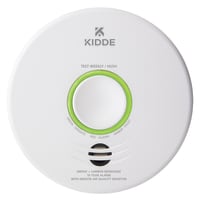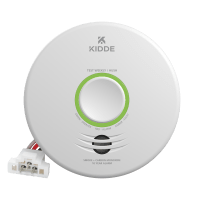What's the Difference Between Carbon Monoxide (CO) and Carbon Dioxide (CO2)?
The chemical makeup of the two gasses is slightly different, but the difference in their effects is extreme. Carbon dioxide is mostly harmless, while carbon monoxide can be fatal.
Where Does Carbon Monoxide Come From?
Carbon monoxide is produced through the fuel-burning process. Here are some examples of what can cause carbon monoxide to build up in your home:
- Any fuel-burning appliance that is malfunctioning or improperly installed
- Furnaces, gas ranges or stoves, gas clothes dryers, water heaters, portable fuel-burning space heaters, fireplaces, generators, and wood burning stoves
- Vehicles, generators, and other combustion engines running in an attached garage
- Blocked chimney or flue
- Cracked or loose furnace exchanger
- Back drafting and changes in air pressure
- Operating a grill in an enclosed space
The heating systems mentioned above can be responsible for CO poisoning, so regular upkeep of furnaces, heaters, dryers, stoves, fireplaces, and generators is important to prevent CO exposure.
What Are the Symptoms of Carbon Monoxide Exposure?
CO enters the body through breathing. CO poisoning can be confused with flu symptoms, food poisoning and other illnesses. Some symptoms include shortness of breath, nausea, dizziness, light headedness or headaches. High levels of CO can be fatal, causing death within minutes.*
If you experience the above symptoms and suspect they might be from CO exposure, leave the house and contact a doctor and emergency services immediately.
How Can I Prevent Carbon Monoxide Exposure?
- Properly equip your home with carbon monoxide alarms on every level and outside sleeping areas.* The only safe way to detect CO in your home is with a CO alarm.
- Every year, have the heating system, vents, chimney, and flue inspected by a qualified technician.
- Regularly examine vents and chimneys for improper connections, visible rust, and stains.
- Install and operate appliances according to the manufacturer's instructions.
- Only purchase appliances that have been approved by a nationally recognized testing laboratory.
- Never use a gas range or stove to heat your home.
- Never leave your car idling in a closed garage or use fuel-powered appliances or tools in enclosed, attached areas such as garages or porches. Carbon monoxide can seep into your home through vents and doors.
What Are The Effects of Various Levels of Carbon Monoxide?
Digital display models show levels of CO, displayed in ppm (parts per million). Anytime the alarm sounds, whether it is an alarm with a digital display or not, it should be treated as a potentially serious situation.
The concentration of CO is a determining factor in the symptoms for an average, healthy adult.*
- 50 ppm: No adverse effects with 8 hours of exposure.
- 200 ppm: Mild headache after 2-3 hours of exposure.
- 400 ppm: Headache and nausea after 1-2 hours of exposure.
- 800 ppm: Headache, nausea, and dizziness after 45 minutes; collapse and unconsciousness after 1 hour of exposure.
- 1,000 ppm: Loss of consciousness after 1 hour of exposure.
- 1,600 ppm: Headache, nausea, and dizziness after 20 minutes of exposure.
- 3,200 ppm: Headache, nausea, and dizziness after 5-10 minutes; collapse and unconsciousness after 30 minutes of exposure.
- 6,400 ppm: Headache and dizziness after 1-2 minutes; unconsciousness and danger of death after 10-15 minutes of exposure.
- 12,800 ppm: Immediate physiological effects, unconsciousness and danger of death after 1-3 minutes of exposure.
Anytime someone is experiencing the symptoms of CO poisoning, it should be treated as an emergency.
- Move them and the family outdoors and call emergency services.
- Do not reenter the premises until emergency services responders have given you permission to do so.
If the alarm reactivates within a 24-hour period, repeat the above steps and call a qualified appliance technician to investigate sources of CO from fuel-burning equipment and appliances, and to inspect for proper operation of equipment.
Do You Need a Carbon Monoxide Alarm?
Yes. You need multiple CO alarms, in fact. One on every level (including the basement) and outside sleeping areas. CO is odorless and invisible, and the only way to detect it is with carbon monoxide alarms.
Where Should I Install Carbon Monoxide Alarms?
Alarms should be installed on every level of a home and outside sleeping areas.
Install carbon monoxide alarms at least 15 feet away from fuel-burning appliances and make sure nothing is covering or obstructing the unit. Do not place the unit in dead air spaces or next to a window or door.
How to Install a Carbon Monoxide Alarm
Once you’ve identified the correct location for a carbon monoxide alarm, installation is simple, but varies from unit to unit. Consult your alarm’s User Guide for step-by-step instructions, or find your CO alarm on our website for the online version of the User Guide (scroll down to the “Documents” tab) if you don’t have it handy.
How to Test a Kidde Carbon Monoxide Alarm
All alarms should be tested weekly to ensure they’re properly operating.
Consult your User Guide for the exact procedure for your unit, but generally speaking, to test the alarm, press the Test/Reset button. If the unit is operating properly, you will hear 4 quick beeps – followed by 5 seconds of silence – followed by 4 quick beeps. (For models with a digital display: The display will show three dash marks “- - -” and then three “eights”.) The red LED will flash along with the beeps. Within several seconds the unit will return to monitor for CO. Note: You do not need to press the Test button to take a CO reading.
Find your CO alarm on our website for the online version of the User Guide (scroll down to the “Documents” tab) if you don’t have it handy.
What Are Peak Levels?
The Peak Level reading is a memory of the highest reading taken by your carbon monoxide alarm since its last reset or power-up. The Peak Level display feature will display levels between 11-999 PPM. Although the Peak Level feature will display levels below 30 PPM, these levels will not result in an alarm no matter how long the device is exposed to these levels.
The Peak Level feature is helpful in identifying if you have had a high CO reading since resetting the alarm (or if it happened while you were away from home). Concentrations of CO between 1 and 30 PPM can often occur in normal, everyday conditions. Concentrations of CO below 30 PPM may be an indication of a transient condition that may appear today and never reappear. Some CO conditions may start out as low-level leaks but could develop into CO concentrations that may become harmful. If this happens, the CO alarm will detect the dangerous level and sound an alarm, notifying you and others of the conditions. DO NOT ignore concentration readings above 30 PPM or a CO alarming device that is sounding its alarm.
Consult the alarm’s User Guide for exact instructions on resetting the Peak Level memory. But generally, you can reset it by pushing the Peak Level button and holding it down while you press and hold the Test/Reset button for 2 seconds, then releasing them at the same time.
Find your CO alarm on our website for the online version of the User Guide (scroll down to the “Documents” tab) if you don’t have it handy.
What to Do When a Carbon Monoxide Alarm Goes Off
Get everyone outside of the home and call 911 from outside or from a neighbor’s home. If you are unable to leave the home to call for help, open the doors and windows, turn off all possible sources of CO while you are waiting for assistance to arrive, and stand by an open door or window. Under no circumstance should an alarm be ignored. Learning to identify why a carbon monoxide alarm is beeping is vital to help keep your family and your home safe.
Who to Call for a Carbon Monoxide Check
If the alarm sounds, vacate the house. Then, it’s best to call 911 or the fire department to come out and test for the source of carbon monoxide. Once they’ve identified what is causing carbon monoxide to be released in your home, you’ll need to contact a licensed professional to service the offending appliance. You can also contact a professional air testing company that can test for carbon monoxide presence and more.
How Do I Dispose of a Carbon Monoxide Alarm?
Different units have different procedures. Consult the User Guide that came with your alarm.
Find your CO alarm on our website for the online version of the User Guide (scroll down to the “Documents” tab) if you don’t have it handy.
*Some of the information on this page has been sourced from the NFPA.org. For more helpful info on carbon monoxide and CO alarms, visitthe NFPA carbon monoxide safety page.






